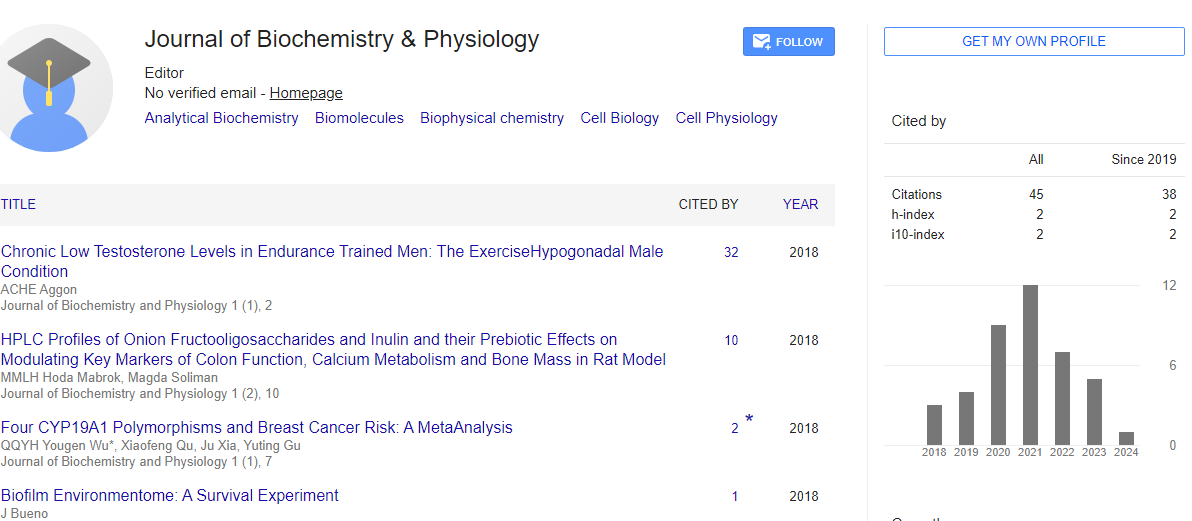Perspective, J Biochem Physiol Vol: 7 Issue: 3
Molecular Physiology of Nutrient Sensing: Mechanisms of Regulation in Health and Disease
Emma Riley*
1Department of Molecular Physiology and Biophysics, Vanderbilt University, Nashville, USA
*Corresponding Author: Emma Riley,
Department of Molecular Physiology and
Biophysics, Vanderbilt University, Nashville, USA
E-mail: emmariley@email.com
Received date: 19 August, 2024, Manuscript No. JBPY-24-149088;
Editor assigned date: 21 August, 2024, PreQC No. JBPY-24-149088 (PQ);
Reviewed date: 04 September, 2024, QC No. JBPY-24-149088;
Revised date: 12 September, 2024, Manuscript No. JBPY-24-149088 (R);
Published date: 19 September, 2024, DOI: 10.4172/jbpy.1000173.
Citation: Riley E (2024) Molecular Physiology of Nutrient Sensing: Mechanisms of Regulation in Health and Disease. J Biochem Physiol 7:3.
Description
Nutrient sensing is a fundamental physiological process that allows organisms to adapt to changes in nutrient availability and maintain energy homeostasis. It involves the detection of various nutrients such as glucose, amino acids and fatty acid by specialized cellular sensors that activate signaling pathways are important for metabolic regulation.
At the core of nutrient sensing are key regulatory proteins and pathways. One of the most significant players is AMP-Activated Protein Kinase (AMPK), which acts as an energy sensor in cells. AMPK is activated when cellular energy levels are low, indicated by a high AMP-to-ATP ratio. Upon activation, AMPK promotes catabolic processes that generate ATP while inhibiting anabolic pathways, such as lipid and protein synthesis. This dual function ensures that energy is conserved during times of nutrient scarcity. In contrast, when nutrients are abundant, AMPK activity is suppressed, allowing for growth and energy storage. Dysregulation of AMPK has been linked to metabolic disorders such as obesity and type 2 diabetes, highlighting its essential role in maintaining metabolic health.
Another important pathway involved in nutrient sensing is the mechanistic Target of Rapamycin (mTOR) pathway. mTOR is a central regulator of cell growth and metabolism that responds primarily to the availability of amino acids, especially leucine. When amino acids are more, mTOR is activated, leading to increased protein synthesis, cell growth and lipid biosynthesis. However, when nutrient levels are low, mTOR activity is inhibited, triggering autophagy, a cellular recycling process that breaks down damaged proteins and organelles to maintain energy balance. The mTOR pathway is often hyperactivated in cancer cells, enabling uncontrolled proliferation, which makes it a promising target for cancer therapies.
Glucose sensing is another critical aspect of nutrient regulation, primarily mediated by glucose transporters and metabolic pathways. When glucose levels rise, cells utilize it for energy through glycolysis and further metabolic processes. The transcription factor carbohydrate-Responsive Element-Binding Protein (ChREBP) plays an essential role in glucose sensing by regulating the expression of genes involved in glucose metabolism. Chronic high glucose levels can impair this sensing mechanism, leading to insulin resistance a hallmark of type 2 diabetes.
Lipid sensing also plays an essential role in metabolic regulation. Fatty acids activate receptors such as Peroxisome Proliferator- Activated Receptors (PPARs), which regulate lipid metabolism by influencing gene expression related to fat storage and oxidation. Proper functioning of PPARs ensures that the body can efficiently use fat stores for energy, especially during fasting. Dysregulation of lipid sensing pathways can contribute to metabolic diseases, including nonalcoholic fatty liver disease and cardiovascular disorders.
Conclusion
Nutrient sensing is an essential component of molecular physiology that governs metabolic responses to nutrient availability. The interplay between various sensors and signaling pathways enables cells to maintain energy homeostasis and adapt to changing environmental conditions. Understanding the molecular physiology of nutrient sensing not only enhances our knowledge of basic biological processes but also provides valuable insights into the pathogenesis of metabolic diseases and cancer.
 Spanish
Spanish  Chinese
Chinese  Russian
Russian  German
German  French
French  Japanese
Japanese  Portuguese
Portuguese  Hindi
Hindi 